
When you think of flying animals, the first things that come to mind are birds. Birds are some of the closest relatives to dinosaurs, and they pretty much own the skies except for insects. However, there are also plenty of animals that fly that aren’t birds. In this article, we’ll discuss nine of the most interesting animals that fly that aren’t birds.
#9 Animal That Flies (That Isn’t a Bird!): Flying Ray
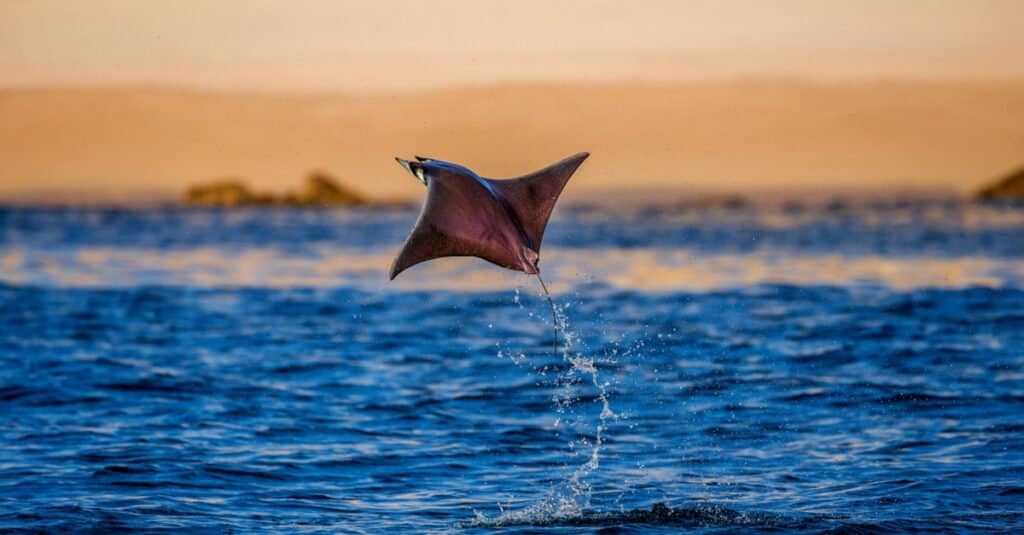
In a spectacular display, some rays can jump out of the water to escape predators.
©GUDKOV ANDREY/Shutterstock.com
Our top spot on the list of animals that fly belongs to the flying ray. More commonly called Mobula rays or devil rays, these flying rays are members of the genus Mobula and are closely related to manta rays. There are 11 recognized species in the genus, and they are found in warm waters all over the world from the Mediterranean Sea to the Pacific Ocean off the coast of California.
These rays can grow as large as 17 feet across and can jump 6 feet up into the air. Like the majority of our list, flying rays are incapable of sustained flight, but they can cover an impressive distance and return to the water with a resounding slap. It is unknown precisely why these rays jump, but researchers suspect it may have something to do with attracting a mate.
Among the multitude of animals in this huge world of ours, there are so many creatures that can fly beyond just birds. Here we have only scratched the surface of the most interesting animals that fly. Flying snakes, devil rays, colugo, and flying squid are just a few of the unexpected species capable of using the sky for transportation and more.
#8 Animal That Flies (That Isn’t a Bird!): Flying Snake
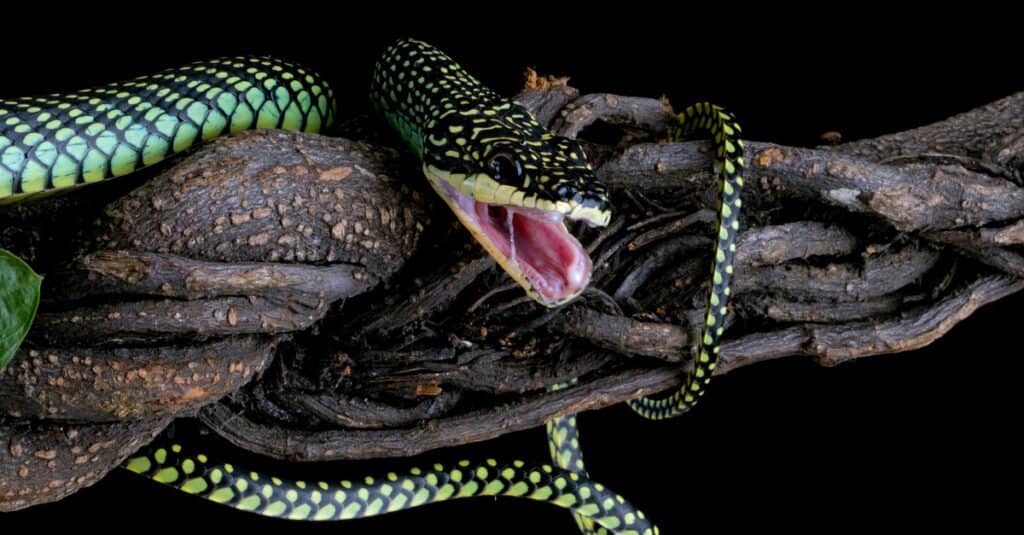
There are five recognized species of flying snakes.
©Kurit afshen/Shutterstock.com
Flying snakes are one of five species from the genus Chrysopelea. These snakes are residents of Western India and the islands of Indonesia, and they can grow up to 4 feet long. Although they glide like many of the other animals on our list, these snakes are actually more nimble fliers than flying squirrels and colugos.
Primarily living in the treetops, flying snakes are thought to jump from branches to escape predators or in search of prey. Once airborne, they flatten their body into a downward-facing, concave shape that allows them to catch air and remain aloft longer. The snakes then use the undulations of their body actually to turn in the air!
#7 Animal That Flies (That Isn’t a Bird!): Colugo
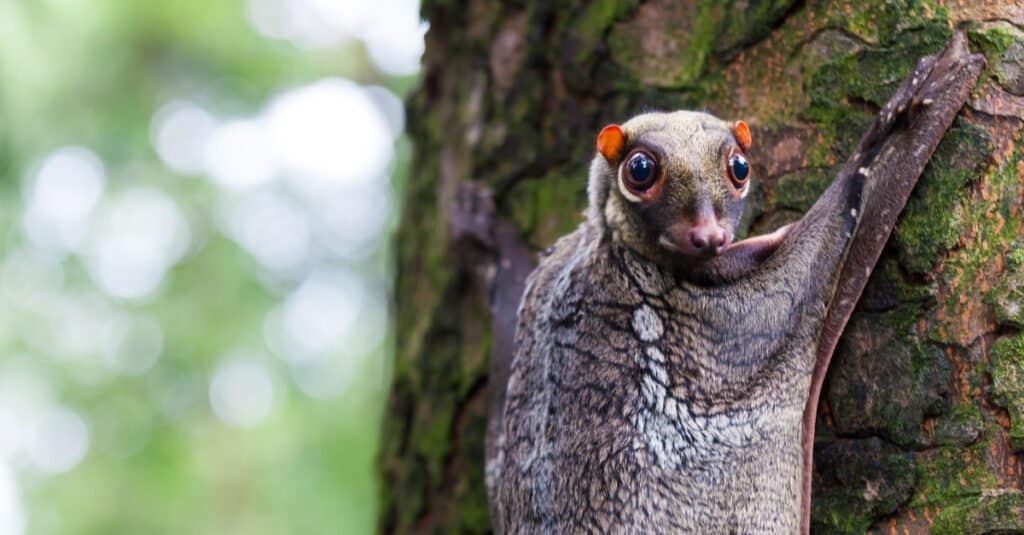
Much like
kangaroos
, mother colugos shelter their babies inside of a pouch.
©Joshua Davenport/Shutterstock.com
Colugos are more commonly referred to as flying lemurs, but the name is a misnomer as they are not actually related to lemurs at all. The closest genetic relatives of the colugo are primates like the great apes. Only two species of this mammal remain which diverged from apes approximately 80 million years ago. Cynocephalus volans of the Philippines and Cynocephalus variegatus of Myanmar and Malaysia share some traits more in common with the flying foxes we spoke about earlier than other mammals.
A unique feature of the colugo is that the webbing connecting its limbs also attaches to their tail and stretches all around its body giving them a bat-like appearance. They are capable of gliding over 230 feet without the loss of any measurable amount of altitude. Nocturnal tree dwellers, these creatures eat a predominantly vegetarian diet unlike many of the other animals mentioned here.
#6 Animal That Flies (That Isn’t a Bird!): Flying Squid
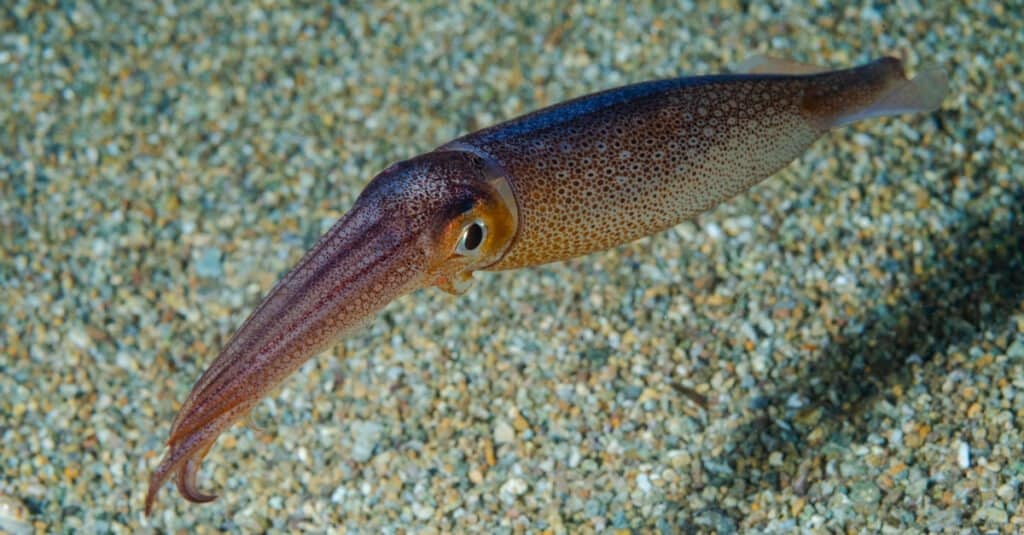
Flying squid have been known to “fly” during migration and to escape predators.
©Shpatak/Shutterstock.com
Flying squid is similar to the flying fish we mentioned earlier in our list except that they are even more surprising. A fish flying by your boat is one thing, but who expects a squid to jump out of the water and fly right by? There are several species of flying squid, but the Japanese flying squid (Todarodes pacificus) has the most striking appearance.
The Japanese flying squid has unique wing-like pectoral fins at the top of its body. They are not used for propulsion, but they do assist the squid with its gliding ability. This squid can be found throughout the Northern Pacific Ocean off the coast of Japan, Russia, China, and even Alaska. Arrow squid (Nototodarus gouldi) have been witnessed expelling jets of water to propel themselves in flights up to 10 feet high over distances of greater than 30 feet.
#5 Animal That Flies (That Isn’t a Bird!): Wallace’s Flying Frog
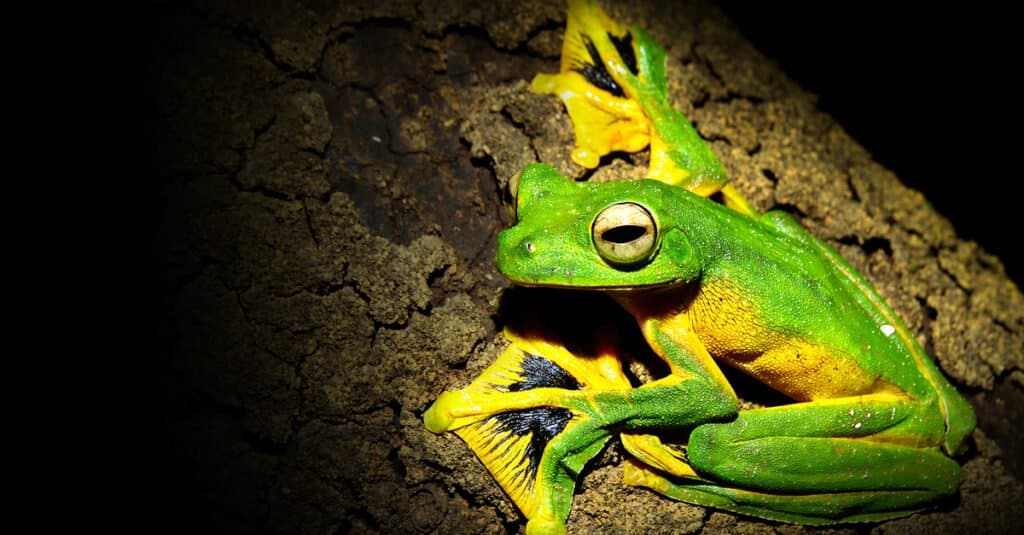
With their unique webbed feet, Wallace’s flying frogs jump between branches.
©Binturong-tonoscarpe/Shutterstock.com
Wallace’s flying frog (Rhacophorus nigropalmatus) is the largest and best-known specimen of several species of flying frogs. Native to the tropical forests of Malaysia and Borneo, Wallace’s flying frog spends the vast majority of its time up in the trees and descends only to lays eggs or mate. They use the webbing between their legs to glide for distances of up to 50 feet after jumping from branches when threatened or hunting insects.
These frogs grow to lengths of 4 inches and are bright green with yellow sides. Distinctive black webbing between their toes sets them apart visually from the other species of flying frogs. These insectivores lay eggs in the wallowing holes of the Asian rhinoceros, and while they are currently considered to be of least concern regarding their conservation status, it is unknown how the rapidly decreasing Asian rhino population will affect them.
#4 Animal That Flies (That Isn’t a Bird!): Flying Squirrel

In one glide, flying squirrels can cover more than 150 feet.
©Laura Fiorillo/Shutterstock.com
Flying squirrels belong to the tribe Pteromyini which encompasses over 50 different species. They are another mammal that does not have true sustained flight but can glide for incredible distances. Layers of loose skin and muscle between their legs allow some species to glide for distances up to 1,500 feet. These squirrels are nocturnal and will jump from treetops and cliffs to begin their flight.
Flying squirrels are not capable of flight like birds or bats; instead, they glide between trees. They are capable of obtaining lift within the course of these flights, with flights recorded to 90 meters (300 ft). The direction and speed of the animal in midair are varied by changing the positions of its limbs, largely controlled by small cartilaginous wrist bones. There is a cartilage projection from the wrist that the squirrel holds upwards during a glide
Some species like the dwarf flying squirrel of the genus Petaurillus are only 3 inches long while the giant flying squirrels of tropical India can grow to 2 feet with an additional 2-foot tail. Several species are found in North America and Europe, but the majority of these squirrels live in the forests of India and Asia.
#3 Animal That Flies (That Isn’t a Bird!): Flying Fish
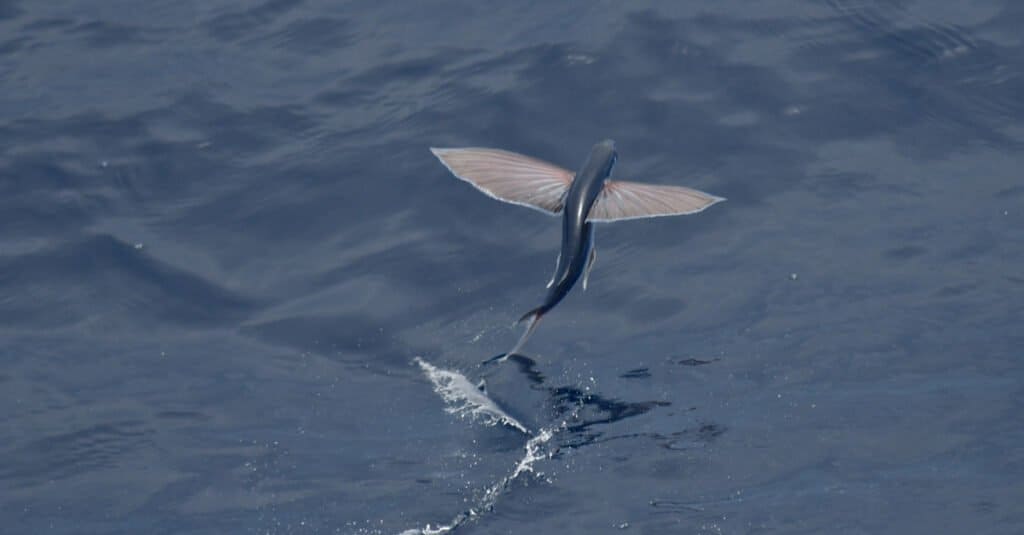
Flying fish have wing-like fins to travel above the surface of the water.
©Agami Photo Agency/Shutterstock.com
Exocoetidae is a family that contains over 40 different species of flying fish. These fish have specialized pectoral fins that can be extended and flattened to allow them to jump out of the water and glide at speeds of up to 37 mph. Flying fish swim powerfully up to the surface and then use their fins to glide for over 600 feet even reaching heights of up to 4 feet.
They are found throughout the world mainly in open oceans, but some species inhabit regions around coral reefs as well. They are common throughout the Atlantic, Pacific, and Indian Oceans. Flying fish grow up to 18 inches long and are attracted to light. Fishermen will sometimes use canoes filled with a small amount of water and affixed with a lure light to entice these fish to jump right into the canoe and catch themselves.
#2 Animal That Flies (That Isn’t a Bird!): Flying Fox
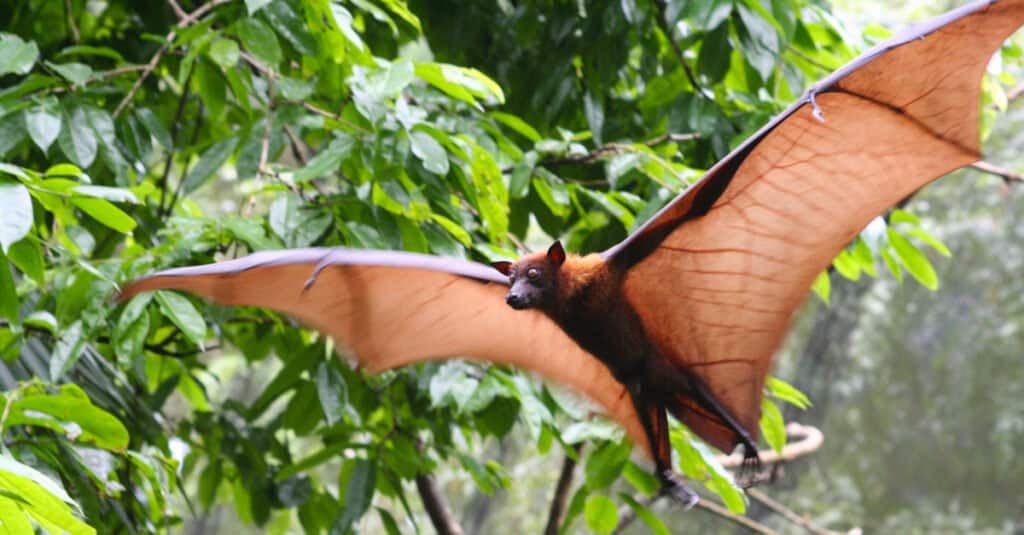
Somewhat deceiving by name, the flying fox is actually a type of fruit bat.
©Erik Zandboer/Shutterstock.com
Next up are any of the 65 species of fruit bats known as flying foxes who are all members of the genus Pteropus. While these are technically also bats, they have so many differences that they warrant their own discussion. Also called old world fruit bats, flying foxes inhabit tropical islands in Malaysia, Indonesia, and Australia, and they are also found in mainland Asia. They navigate by sight rather than echolocation like other bats and primarily eat fruit.
The smallest flying foxes are some of the smallest bats in the world. The long-tongued nectar bat (Macroglossus minimus) reaches only 2-3 inches long with a wingspan of just 10 inches, and they use their tongue to collect pollen and nectar. Members of the flying fox family are better known for being some of the largest species of bats in the world as well. The golden-crowned flying fox (Acerodon jubatus) has a six-foot wingspan, and it’s big enough that it is actually hunted by humans for food!
#1 Animal That Flies (That Isn’t a Bird!): Bat

Perhaps the most widespread of all flying animals in terms of location, bats can be found worldwide.
©Rudmer Zwerver/Shutterstock.com
Bats are of the order Chiroptera, and they are the only flying mammal. Ranging in size from the tiny bumblebee bat (Craseonycteris thonglongyai) which weighs only 0.07 ounces up to the golden-crowned flying fox (Acerodon jubatus) which can weigh 3 pounds, these animals eat a wide variety of things like insects, fruit, nectar, and animal blood.
Bats are found throughout the world with the vast majority of them being nocturnal. Their thin, membranous wings are a distinct method of propulsion, and they can all be easily identified by their unique manner of flight. Insectivorous bats can be found roosting in caves in groups of up to several thousand members while other bats live solitary lives. Some people even build bat houses on their property to encourage bats to take up residence and rid them of other flying pests.
To avoid “flying blind,” bats use a technique called echolocation, a process of using reflected sound to navigate and locate objects in the dark–even pitch darkness. This allows bats to get around with ease in caves and find insects that fly at night.
Summary of 9 Animals That Fly (That Aren’t Birds)
To recap, there are multiple varieties of animals that can fly besides birds:
| Rank | Animal |
|---|---|
| 1 | Bat |
| 2 | Flying Fox |
| 3 | Flying Fish |
| 4 | Flying Squirrel |
| 5 | Wallace’s Flying Frog |
| 6 | Flying Squid |
| 7 | Colugo |
| 8 | Flying Snake |
| 9 | Flying Ray |
The photo featured at the top of this post is © Binturong-tonoscarpe/Shutterstock.com
Thank you for reading! Have some feedback for us? Contact the AZ Animals editorial team.






